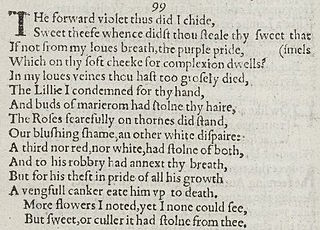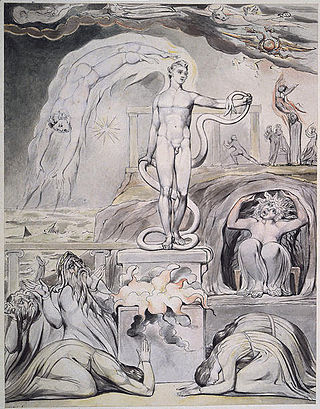A heroic couplet is a traditional form for English poetry, commonly used in epic and narrative poetry, and consisting of a rhyming pair of lines in iambic pentameter. Use of the heroic couplet was pioneered by Geoffrey Chaucer in the Legend of Good Women and the Canterbury Tales, and generally considered to have been perfected by John Dryden and Alexander Pope in the Restoration Age and early 18th century respectively.
Hexameter is a metrical line of verses consisting of six feet. It was the standard epic metre in classical Greek and Latin literature, such as in the Iliad, Odyssey and Aeneid. Its use in other genres of composition include Horace's satires, Ovid's Metamorphoses, and the Hymns of Orpheus. According to Greek mythology, hexameter was invented by Phemonoe, daughter of Apollo and the first Pythia of Delphi.
In poetry, metre or meter is the basic rhythmic structure of a verse or lines in verse. Many traditional verse forms prescribe a specific verse metre, or a certain set of metres alternating in a particular order. The study and the actual use of metres and forms of versification are both known as prosody.
An anapaest is a metrical foot used in formal poetry. In classical quantitative meters it consists of two short syllables followed by a long one; in accentual stress meters it consists of two unstressed syllables followed by one stressed syllable. It may be seen as a reversed dactyl. This word comes from the Greek ἀνάπαιστος, anápaistos, literally "struck back" and in a poetic context "a dactyl reversed".
Pentameter is a poetic meter. А poem is said to be written in a particular pentameter when the lines of the poem have the length of five feet, where a 'foot' is a combination of a particular number of unstressed syllables and a stressed syllable. Depending on the pattern of feet, pentameter can be iambic or dactylic.
Rhyme royal is a rhyming stanza form that was introduced to English poetry by Geoffrey Chaucer. The form enjoyed significant success in the fifteenth century and into the sixteenth century. It has had a more subdued but continuing influence on English verse in more recent centuries.
Terza rima is a rhyming verse form, in which the poem, or each poem-section, consists of tercets with an interlocking three-line rhyme scheme: The last word of the second line in one tercet provides the rhyme for the first and third lines in the tercet that follows. The poem or poem-section may have any number of lines, but it ends with either a single line or a couplet, which repeats the rhyme of the middle line of the previous tercet.
Iambic pentameter is a type of metric line used in traditional English poetry and verse drama. The term describes the rhythm, or meter, established by the words in each line. Rhythm is measured in small groups of syllables called "feet". "Iambic" indicates that the type of foot used is the iamb, which in English is an unstressed syllable followed by a stressed syllable. "Pentameter" indicates that each line has five "feet".

Heroic verse is a term that may be used to designate epic poems, but which is more usually used to describe the meter(s) in which those poems are most typically written. Because the meter typically used to narrate heroic deeds differs by language and even within language by period, the specific meaning of "heroic verse" is dependent upon context.
An acatalectic line of verse is one having the metrically complete number of syllables in the final foot. When talking about poetry written in English the term is arguably of limited significance or utility, at least by comparison to its antonym, catalectic, for the simple reason that acatalexis is considered to be the "usual case" in the large majority of metrical contexts and therefore explicit reference to it proves almost universally superfluous.
Decasyllable is a poetic meter of ten syllables used in poetic traditions of syllabic verse. In languages with a stress accent, it is the equivalent of pentameter with iambs or trochees.
This is a glossary of poetry terms.
Fra Lippo Lippi is an 1855 dramatic monologue written by the Victorian poet Robert Browning which first appeared in his collection Men and Women. Throughout this poem, Browning depicts a 15th-century real-life painter, Filippo Lippi. The poem asks the question whether art should be true to life or an idealized image of life. The poem is written in blank verse, non-rhyming iambic pentameter.

Sonnet 66 is one of 154 sonnets written by the English playwright and poet William Shakespeare. It's a member of the Fair Youth sequence, in which the poet expresses his love towards a young man.
The following outline is provided as an overview of and introduction to poetry:

Sonnet 99 is one of 154 sonnets written by the English playwright and poet William Shakespeare. It is a member of the Fair Youth sequence, in which the poet expresses his love towards a young man. The sonnet is generally grouped with the preceding two in the sequence, with which it shares a dominant trope and image set: the beloved is described in terms of, and judged superior to, nature and its beauties.

Sonnet 123 is one of 154 sonnets written by the English playwright and poet William Shakespeare. It is a member of the Fair Youth sequence, in which the poet expresses his love towards a young man.

On the Morning of Christ's Nativity is a nativity ode written by John Milton in 1629 and published in his Poems of Mr. John Milton (1645). The poem describes Christ's Incarnation and his overthrow of earthly and pagan powers. The poem also connects the Incarnation with Christ's Crucifixion.
"After Apple-Picking" is a poem by American poet Robert Frost. It was published in 1914 in North of Boston, Frost's second poetry collection. The poem, 42 lines in length, does not strictly follow a particular form, nor does it follow a standard rhyme scheme.
Poetic devices are a form of literary device used in poetry. Poems are created out of poetic devices via a composite of: structural, grammatical, rhythmic, metrical, verbal, and visual elements. They are essential tools that a poet uses to create rhythm, enhance a poem's meaning, or intensify a mood or feeling.
 Within and Without public domain audiobook at LibriVox
Within and Without public domain audiobook at LibriVox 



